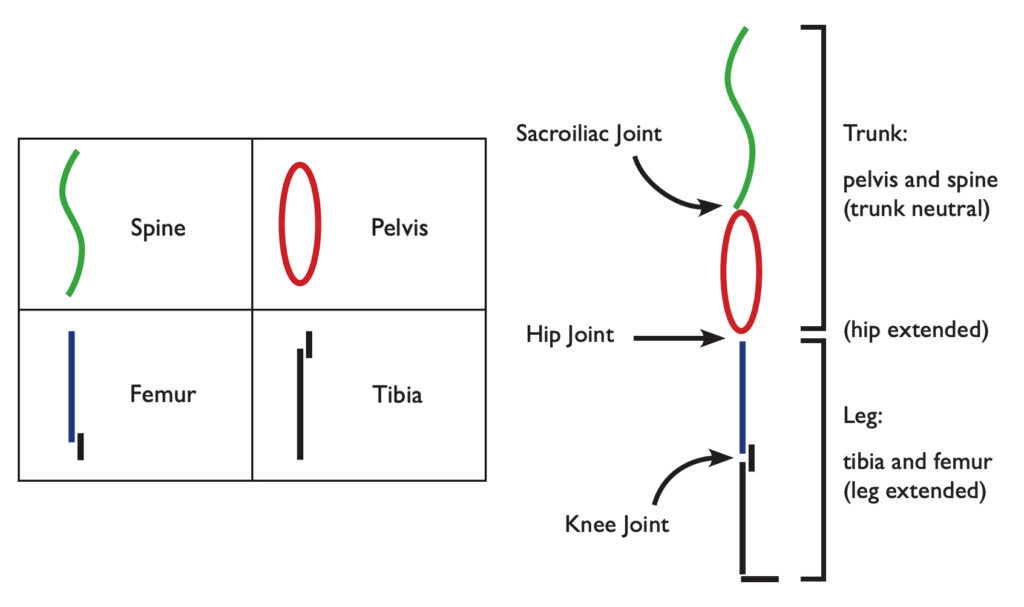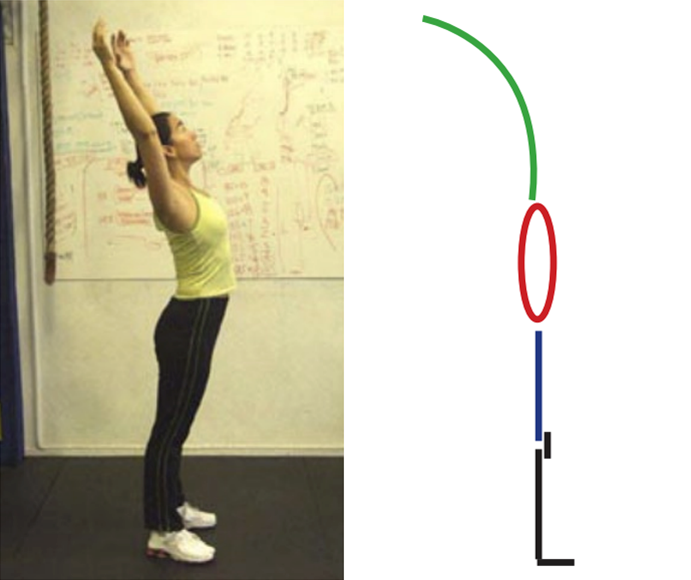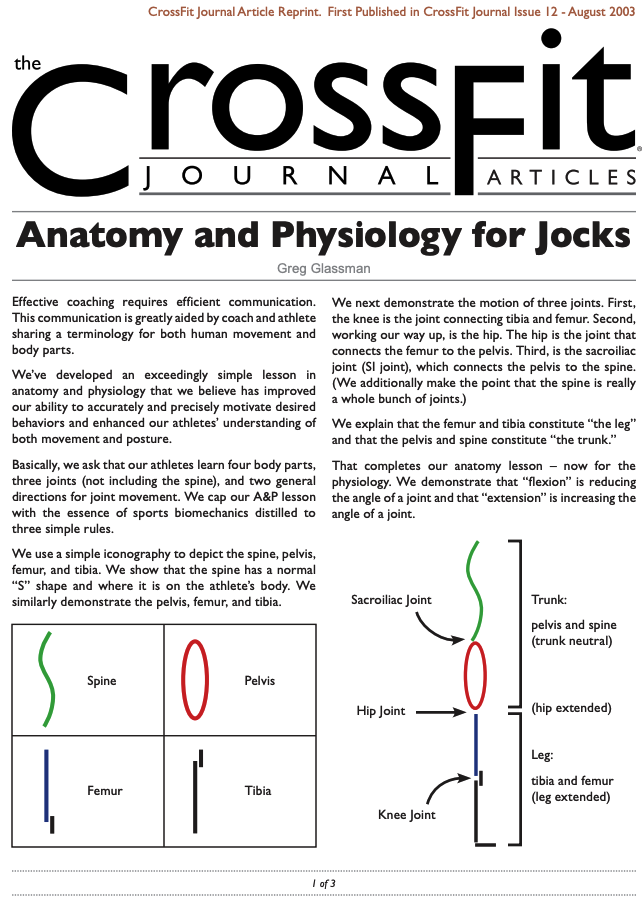Effective coaching requires efficient communication. This communication is greatly aided by coach and athlete sharing a terminology for both human movement and body parts.
We’ve developed an exceedingly simple lesson in anatomy and physiology that we believe has improved our ability to accurately and precisely motivate desired behaviors and enhanced our athletes’ understanding of both movement and posture.
Basically, we ask that our athletes learn four body parts, three joints (not including the spine) and two general directions for joint movement. We cap our A&P lesson with the essence of sports biomechanics distilled to three simple rules.
We use a simple iconography to depict the spine, pelvis, femur and tibia. We show that the spine has a normal “S” shape and where it is on the athlete’s body. We similarly demonstrate the pelvis, femur and tibia.

We next demonstrate the motion of three joints. First, the knee is the joint connecting tibia and femur. Second, working our way up, is the hip. The hip is the joint that connects the femur to the pelvis. Third is the sacroiliac joint (SI joint), which connects the pelvis to the spine. (We additionally make the point that the spine is really a whole bunch of joints.)
We explain that the femur and tibia constitute “the leg” and that the pelvis and spine constitute “the trunk.”
That completes our anatomy lesson—now for the physiology. We demonstrate that “flexion” is reducing the angle of a joint and that “extension” is increasing the angle of a joint.
Before covering our distillation of essential biomechanics we test our students to see if everyone can flex and extend their knee (or “leg”), hip, spine and sacroiliac joint (or “trunk”) on cue. When it is clear that the difference between flexion and extension is understood at each joint we cue for combinations of behaviors, for instance, “flex one leg and trunk but not your hip.”
Once the joints, parts and movements are clear we offer these three tidbits of biomechanics:
- Functional movement generally weds the spine to the pelvis. The SI joint and spine were designed for small range movement in multiple directions. Endeavor to keep the trunk tight and solid for running, jumping, squatting, throwing, cycling, etc.
- The dynamics of those movements come from the hip—primarily extension. Powerful hip extension is certainly necessary and nearly sufficient for elite athletic capacity.
- Do not let the pelvis chase the femur instead of the spine. We’ve referred to this in the past as “muted hip function” (CFJ issue 05, January 2003). We also call it “frozen hip” because when the pelvis chases the femur the hip angle remains open and is consequently powerless to extend.
Four parts, three joints, two motions and three rules give our athletes and us a simple but powerful lexicon and understanding whose immediate effect is to render our athletes at once more “coachable.” We couldn’t ask for more.
This article, by BSI’s co-founder, was originally published in The CrossFit Journal. While Greg Glassman no longer owns CrossFit Inc., his writings and ideas revolutionized the world of fitness, and are reproduced here.
Coach Glassman named his training methodology ‘CrossFit,’ which became a trademarked term owned by CrossFit Inc. In order to preserve his writings in their original form, references to ‘CrossFit’ remain in this article.
Greg Glassman founded CrossFit, a fitness revolution. Under Glassman’s leadership there were around 4 million CrossFitters, 300,000 CrossFit coaches and 15,000 physical locations, known as affiliates, where his prescribed methodology: constantly varied functional movements executed at high intensity, were practiced daily. CrossFit became known as the solution to the world’s greatest problem, chronic illness.
In 2002, he became the first person in exercise physiology to apply a scientific definition to the word fitness. As the son of an aerospace engineer, Glassman learned the principles of science at a young age. Through observations, experimentation, testing, and retesting, Glassman created a program that brought unprecedented results to his clients. He shared his methodology with the world through The CrossFit Journal and in-person seminars. Harvard Business School proclaimed that CrossFit was the world’s fastest growing business.
The business, which challenged conventional business models and financially upset the health and wellness industry, brought plenty of negative attention to Glassman and CrossFit. The company’s low carbohydrate nutrition prescription threatened the sugar industry and led to a series of lawsuits after a peer-reviewed journal falsified data claiming Glassman’s methodology caused injuries. A federal judge called it the biggest case of scientific misconduct and fraud she’d seen in all her years on the bench. After this experience Glassman developed a deep interest in the corruption of modern science for private interests. He launched CrossFit Health which mobilized 20,000 doctors who knew from their experiences with CrossFit that Glassman’s methodology prevented and cured chronic diseases. Glassman networked the doctors, exposed them to researchers in a variety of fields and encouraged them to work together and further support efforts to expose the problems in medicine and work together on preventative measures.
In 2020, Greg sold CrossFit and focused his attention on the broader issues in modern science. He’d learned from his experience in fitness that areas of study without definitions, without ways of measuring and replicating results are ripe for corruption and manipulation.
The Broken Science Initiative, aims to expose and equip anyone interested with the tools to protect themself from the ills of modern medicine and broken science at-large.
Support the Broken Science Initiative.
Subscribe today →
recent posts
‘Black box’ safety warning to be removed from hormone therapy for menopause












